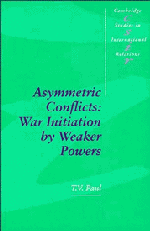Book contents
- Frontmatter
- Contents
- List of tables
- Preface
- PART I THE THEORETICAL FRAMEWORK
- PART II THE CASE STUDIES
- 3 The Japanese offensive against Russia, 1904
- 4 The Japanese attack on Pearl Harbor, 1941
- 5 The Chinese intervention in Korea, 1950
- 6 The Pakistani offensive in Kashmir, 1965
- 7 The Egyptian offensive in the Sinai, 1973
- 8 The Argentine invasion of the Falklands/Malvinas, 1982
- Conclusion
- Notes
- Bibliography
- Index
- Titles in the series
8 - The Argentine invasion of the Falklands/Malvinas, 1982
Published online by Cambridge University Press: 03 May 2011
- Frontmatter
- Contents
- List of tables
- Preface
- PART I THE THEORETICAL FRAMEWORK
- PART II THE CASE STUDIES
- 3 The Japanese offensive against Russia, 1904
- 4 The Japanese attack on Pearl Harbor, 1941
- 5 The Chinese intervention in Korea, 1950
- 6 The Pakistani offensive in Kashmir, 1965
- 7 The Egyptian offensive in the Sinai, 1973
- 8 The Argentine invasion of the Falklands/Malvinas, 1982
- Conclusion
- Notes
- Bibliography
- Index
- Titles in the series
Summary
The South Atlantic War of 1982, sparked off by the Argentine invasion of the Falklands (Malvinas) Islands, is an asymmetric conflict in which the weaker side initiated the war. The balance of capabilities in 1982 was clearly in favor of Britain, the defending state in this conflict. In manpower alone, Britain held a major advantage, as its fighting forces comprised professionally trained volunteer soldiers, while that of Argentina's consisted of conscripts, who were mostly below twenty years of age. Britain's military expenditure was six times higher than Argentina's, allowing it to have superiority in firepower, technology, and training. The Argentine military's heavy involvement in internal politics and the intra-service rivalries resulted in the development of a force structure less cohesive than that of Britain. Several Argentine commanders were political appointees whose promotion to higher echelons was not always based on their professional competence. Although prior to the arrival of the British task force in the South Atlantic, Argentina held limited tactical advantages in the theater due to its proximity to the Islands, this proved to be of short-term value as Buenos Aires lacked comparable landing facilities, such as aircraft carriers, that Britain possessed. Being over 400 miles away from the mainland, the Islands were at the outer limits of the combat radii of the Argentine aircraft that had to fly from home ports for military missions, thereby greatly diminishing their weapon-carrying capability.
- Type
- Chapter
- Information
- Asymmetric ConflictsWar Initiation by Weaker Powers, pp. 146 - 166Publisher: Cambridge University PressPrint publication year: 1994



